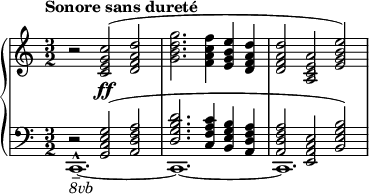In music, parallel harmony, also known as harmonic parallelism, harmonic planing or parallel voice leading, is the parallel movement of two or more melodies (see voice leading).
When all voices between chords move in parallel motion, this generally reduces or negates the effect of harmonic progression. However, "occasionally chords such as the tonic and dominant may create the sense of harmonic progression".[1]
Lines with parallel harmony can be viewed as a series of chords with the same intervallic structure. Parallel means that each note within the chord rises or falls by the same interval.



Prominent examples include:
In the Schuman example (Three Score Set for Piano), the inversions of the chords suggest a bichordal effect.[3]
In the example on the top right, we see a series of quartal chords in parallel motion, in which the intervallic relationship between each consecutive chord member, in this case a minor second, is consistent. Each note in the chord falls by one semitone in each step, from F, B♭, and E♭ in the first chord to D, G, and C in the last.
Parallel harmony is frequently used in house music and other electronic music genres. Historically, this resulted from producers sampling chords from soul or jazz and then playing them at different pitches, or using "chord memory" feature from classic polyphonic synthesizers. Modern digital audio workstations offer similar chord-generating tools for achieving parallel harmony.[4]
wikipedians
This is the start of the #wikipedians chat. #wikipedians — chat for Wikipedians about leveraging the hub to improve its root Wikipedia article.